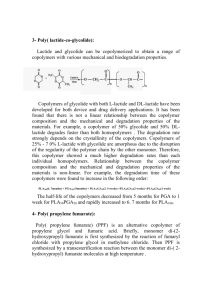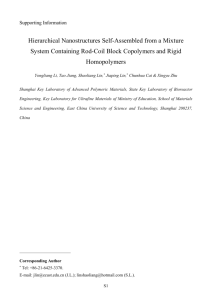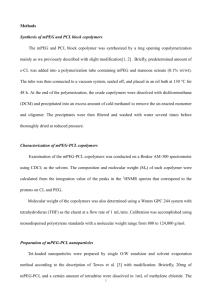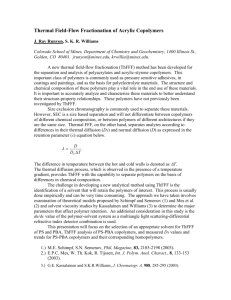Synthesis of well-defined copolymers
advertisement
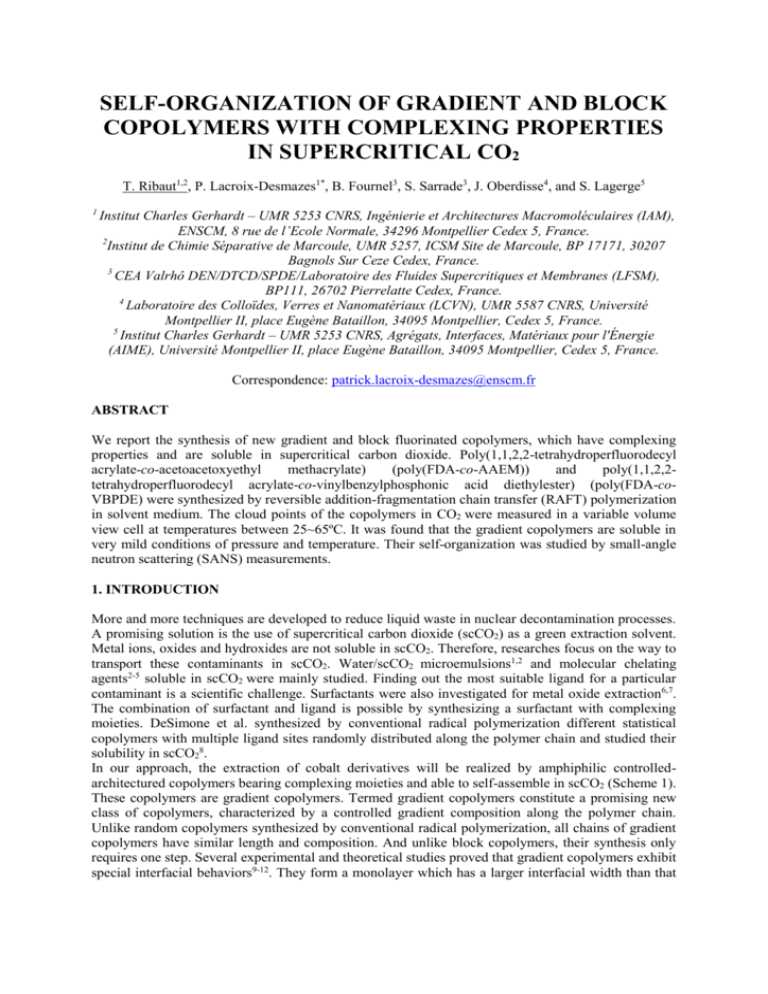
SELF-ORGANIZATION OF GRADIENT AND BLOCK COPOLYMERS WITH COMPLEXING PROPERTIES IN SUPERCRITICAL CO2 T. Ribaut1,2, P. Lacroix-Desmazes1*, B. Fournel3, S. Sarrade3, J. Oberdisse4, and S. Lagerge5 1 Institut Charles Gerhardt – UMR 5253 CNRS, Ingénierie et Architectures Macromoléculaires (IAM), ENSCM, 8 rue de l’Ecole Normale, 34296 Montpellier Cedex 5, France. 2 Institut de Chimie Séparative de Marcoule, UMR 5257, ICSM Site de Marcoule, BP 17171, 30207 Bagnols Sur Ceze Cedex, France. 3 CEA Valrhô DEN/DTCD/SPDE/Laboratoire des Fluides Supercritiques et Membranes (LFSM), BP111, 26702 Pierrelatte Cedex, France. 4 Laboratoire des Colloïdes, Verres et Nanomatériaux (LCVN), UMR 5587 CNRS, Université Montpellier II, place Eugène Bataillon, 34095 Montpellier, Cedex 5, France. 5 Institut Charles Gerhardt – UMR 5253 CNRS, Agrégats, Interfaces, Matériaux pour l'Énergie (AIME), Université Montpellier II, place Eugène Bataillon, 34095 Montpellier, Cedex 5, France. Correspondence: patrick.lacroix-desmazes@enscm.fr ABSTRACT We report the synthesis of new gradient and block fluorinated copolymers, which have complexing properties and are soluble in supercritical carbon dioxide. Poly(1,1,2,2-tetrahydroperfluorodecyl acrylate-co-acetoacetoxyethyl methacrylate) (poly(FDA-co-AAEM)) and poly(1,1,2,2tetrahydroperfluorodecyl acrylate-co-vinylbenzylphosphonic acid diethylester) (poly(FDA-coVBPDE) were synthesized by reversible addition-fragmentation chain transfer (RAFT) polymerization in solvent medium. The cloud points of the copolymers in CO2 were measured in a variable volume view cell at temperatures between 25~65ºC. It was found that the gradient copolymers are soluble in very mild conditions of pressure and temperature. Their self-organization was studied by small-angle neutron scattering (SANS) measurements. 1. INTRODUCTION More and more techniques are developed to reduce liquid waste in nuclear decontamination processes. A promising solution is the use of supercritical carbon dioxide (scCO2) as a green extraction solvent. Metal ions, oxides and hydroxides are not soluble in scCO2. Therefore, researches focus on the way to transport these contaminants in scCO2. Water/scCO2 microemulsions1,2 and molecular chelating agents2-5 soluble in scCO2 were mainly studied. Finding out the most suitable ligand for a particular contaminant is a scientific challenge. Surfactants were also investigated for metal oxide extraction6,7. The combination of surfactant and ligand is possible by synthesizing a surfactant with complexing moieties. DeSimone et al. synthesized by conventional radical polymerization different statistical copolymers with multiple ligand sites randomly distributed along the polymer chain and studied their solubility in scCO28. In our approach, the extraction of cobalt derivatives will be realized by amphiphilic controlledarchitectured copolymers bearing complexing moieties and able to self-assemble in scCO2 (Scheme 1). These copolymers are gradient copolymers. Termed gradient copolymers constitute a promising new class of copolymers, characterized by a controlled gradient composition along the polymer chain. Unlike random copolymers synthesized by conventional radical polymerization, all chains of gradient copolymers have similar length and composition. And unlike block copolymers, their synthesis only requires one step. Several experimental and theoretical studies proved that gradient copolymers exhibit special interfacial behaviors9-12. They form a monolayer which has a larger interfacial width than that of block copolymers13. Furthermore, contrary to amphiphilic diblock copolymers, which tend to form frozen aggregates, some gradient copolymers are at equilibrium and able to exchange free chains in reasonable time scales. They consequently have a better surface activity14. Block and gradient copolymers are attainable by controlled radical polymerization. Reversible addition-fragmentation chain transfer polymerization (RAFT) is a reliable controlled radical polymerization method, due to the versatility of monomers which can be polymerized and the mildness of the reaction conditions. The gradient copolymers synthesized herein are new and contain a CO2-philic part and complexing moieties. The CO2-philic polymer is poly(1,1,2,2-tetrahydroperfluorodecylacrylate) (poly(FDA)) which was already proved to be extremely soluble in scCO215 and the complexing groups are poly(AAEM) or poly(VBPDE) which can afford the phosphonic diacid moiety after hydrolysis (poly(VBPDA)). Aggregation in scCO2 has been studied by SANS for several kinds of polymers (homopolymers, graft and block copolymers)16-19, but gradient copolymers were rarely studied by SANS20 and never in scCO2. FDA unit: CO2-phobic CO2-philic Block copolymer: Slow Exchange: O O Unimer C8F17 Self-organization of block copolymer chains in scCO2 CO2-phobic CO2-philic Gradient copolymer: AAEM or VBPDE units: O H3C Fast Exchange: O O Unimer O O CH2 P EtO OEt O Self-organization of gradient copolymer chains in scCO2 Scheme 1: Self-organization of copolymer chains in scCO2. 2. EXPERIMENTAL Materials 1,1,2,2-tetrahydroperfluorodecylacrylate (FDA, Atofina) and acetoacetoxyethylmethacrylate (AAEM, Eastman, 97 %) were purified by passing through activated basic aluminum oxide and neutral aluminum oxide respectively. Azobis(isobutyronitrile) (AIBN) was recrystallized from cold methanol and dried in vacuum. α,α,α-trifluorotoluene (TFT, Lancaster, 99 %) was distilled before use. VBPDE was synthesized as described in the literature21. The chain transfer agent (CTA) 1-(ethoxycarbonyl)ethyl dithiobenzoate was synthesized as described elsewhere22. 1,1,2 Trichlorotrifluoroethane (F113, Aldrich, 99%), CO2 (99.99992 %, SFE 5.2, Linde Gas SA, France) and all other chemicals were used as received unless otherwise stated. Synthesis of polymers by RAFT polymerization All polymerizations were carried out with a molar ratio [AIBN]/[CTA]=0.3 and an initial concentration in monomer of 0.8 g per mL of solvent. AIBN, CTA, the monomers and TFT were introduced along with a stir bar in a Schlenk flask. After three freeze-pump-thaw cycles, the polymerization was performed at 65 °C under argon. After solvent evaporation, the polymer was washed with n-pentane 95 %, and then dried under vacuum. Characterization 1 H NMR spectra were recorded at room temperature on a Bruker 400 Ultra Shield spectrometer (400 MHz). Conversions of monomers were determined by 1H NMR analysis of the crude reaction medium with deuterated benzene (C6D6) capillaries. The composition of the purified copolymers was determined by 1H NMR spectroscopy in F113 with deuterated benzene (C6D6) capillaries. Molecular weights were calculated according to 1H NMR chain-end analysis. Cloud-points measurements Cloud-points measurements were carried out in a high-pressure, variable volume view cell according to a procedure previously reported23,24. Small-Angle Neutron Scattering SANS data were collected at the Laboratoire Leon Brillouin (LLB), CEA Saclay, France, on beam line PACE. Experimental procedures will be described in a following paper. Data presented here have been corrected for empty cell scattering and converted to absolute units (cm-1). 3. RESULTS AND DISCUSSION Synthesis of well-defined copolymers Because of the controlled character of the RAFT polymerization, the architecture of gradient copolymers only depends on the reactivity ratios (r1=k11/k12 and r2= k22/k21) of the monomers M1 and M2. Since the reactivity ratio r1 of an acrylate monomer is less than the reactivity ratio r2 of the methacrylate and styrenic monomers25, AAEM (M2) thus reacts faster than FDA (M1) and the obtained copolymer is a gradient copolymer. The same holds for VBPDE (M2) (Table 1). Table 1: Characterization of the synthesized polymers Mn (g/mol) Run Monomer M2 Type Monomer conversion (%) Overall weight Conversion (%) Theoretical 1 None 2 AAEM 3 AAEM 4 AAEM 5 VBPDE 6 VBPDE HomoPoly(FDA) Gradient Copolymer Gradient Copolymer Gradient Copolymer Gradient Copolymer Block Copolymer 76.5 AAEM: 96.0 FDA: 83.8 AAEM: 99.4 FDA: 87.6 AAEM: 98.8 FDA: 76.7 VBPDE: 90.8 FDA: 68.3 VBPDE: 56.5 FDA: 79.1 Molar fraction of M2 (%) (1H NMR chain-end Theoretical analysis) 1 H NMR (washed polymer) 14300 17300 None 84.6 16000 19000 16.8 14.3 89.0 16300 22000 27.5 24.2 87.2 15400 16200 45.8 47.5 70.1 13200 12500 18.9 18 - 20600 23300 23.5 17.6 Solubility in scCO2 Gradient copolymers poly(FDA-co-AAEM) are very soluble and their cloud point curves are logically above the poly(FDA) homopolymer curve (figure 1). As predicted, the phase behavior of these gradient copolymers depends on the amount of non-fluorinated units in the chain, that is the CO2philic/CO2-phobic balance: incorporation of AAEM units increases the cloud point pressure at a given temperature. But very interestingly, they are soluble at much lower pressures than random copolymers poly(FDA-co-AAEM) synthesized by conventional radical polymerization and having nearly the same molar percentages of AAEM units8,26. The gradient copolymer poly(FDA-co-VBPDE) 18 % mol VBPDE is also very soluble. Its cloud point values are equivalent to those of poly(FDA-co-AAEM) 14 % mol AAEM. In contrast, cloud point values of the block copolymer poly(VBPDE)-b-poly(FDA) 18 % mol VBPDE are much higher (25<T<65 °C, 260<P<360 bars). Thus, gradient copolymers seem to be soluble at much lower pressure than block copolymers. 300 P (bars) 250 200 150 100 50 15 25 35 45 55 65 T (°C) Figure 1: Cloud points (4 % wt of polymer versus CO2) of poly(FDA-co-AAEM) gradient copolymers 14 % mol AAEM (■), 24 % mol AAEM (●), 48 % mol AAEM (▲), and poly(FDA) homopolymer (◊) all synthesized by RAFT polymerization (this work), in comparison with poly(FDA-co-AAEM) random copolymers 15 % mol AAEM (■) and 25 % mol AAEM (●) synthesized by conventional radical polymerization (DeSimone et al.8,26). SANS study of the self-organization of poly(FDA-co-AAEM) with AAEM 15 % mol Self-organization of this gradient copolymer was studied at 40 °C and at two pressures (140 bar, 210 bar) by SANS. The scattered intensities are shown in Figure 2. Despite the high concentration of polymer (8 % wt of polymer versus CO2), low absolute intensities were measured and pure form factor scattering was observed. The absence of a structure factor peak implied that scattering reflected the structure of isolated objects. Low intensities indicated that these objects had rather low mass and are due to the low contrasts (T=40 °C; P=140 bar, ρ(CO2)=1.91*1010 cm-2 and ρ(copolymer)=3.18*1010 cm-2; P=210 bar, ρ(CO2)=2.12*1010 cm-2 and ρ(copolymer)=3.18*1010 cm-2). More specifically, the low-angle intensity limit was used to extract the average aggregation number. By changing the pressure from 140 to 210 bar, changes of aggregation can be noticed in Figure 2: the aggregation number decreased from 5 to 2. For finite q-vectors, the scattered intensity decreased, as one would expect for form factors. This decay can be described at small angles by a Guinier law (I=I0*exp(-q2Rg2/3)). As shown in Figure 2, we determined the radii of gyration Rg of the copolymers: 47 and 22 Å, at 140 and 210 bar, respectively. These values can be compared with the theoretical estimation of the Rg of a single copolymer chain in CO2 (15 Å). Thus, the size of aggregates decreased with increasing pressure. This phenomenon was already observed for solutions of block copolymers in scCO217,19,27,28: the increase in the surface area of block copolymer in contact with the solvent was explained by the higher solubility of polymers when CO2 density increases. The solvent quality of CO2 for poly(FDA) homopolymer was indeed shown to increase with CO2 pressure15. Gradient copolymers seem thus to be as able to pressure-induced micellization as block copolymers. The difference between the volume deduced from Guinier approximation, and the dry volume of the gradient copolymer aggregate deduced from I0, showed an important solvation of the copolymer chains: V(CO2)/V(polymer)=11.1 at 140 bar and 1.9 at 210 bar. If we consider the weights: m(CO2)/m(polymer)=5.1 at 140 bar and 1 at 210 bar. From these calculations, each gradient copolymer chain is surrounded by 1850 molecules of CO2 at 140 bar and 360 molecules of CO2 at 210 bar. 1 0.9 0.8 I(cm-1) 0.7 0.6 0.5 0.4 0.3 0.2 0.1 0 0 0.05 0.1 q(Å-1) 0.15 0.2 Figure 2: SANS data for poly(FDA-co-AAEM) gradient copolymer 15 % mol AAEM (T=40°C, P=140 bar (□) or P=210 bar (○)) (8 % wt of polymer versus CO2) and the corresponding Guinier plots. Extraction of cobalt derivatives Gradient copolymers were shown to increase the sedimentation time of cobalt hydroxide (Co(OH)2) dispersions in scCO2. This enhanced stability indicates a favored interaction between the polymer and the contaminant. 4. CONCLUSION This work confirmed that RAFT polymerization is an appropriate method to obtain semifluorinated well-architectured copolymers. Poly(FDA-co-AAEM) and poly(FDA-co-VBPDE) gradient copolymers, as well as poly(VBPDE)-b-poly(FDA) block copolymer, were synthesized with good conversions. The gradient copolymers exhibit remarkable CO2 solubility that will allow using them as complexing surfactants for extraction of metallic derivatives in scCO2. Furthermore, SANS study of the gradient copolymer poly(FDA-co-AAEM) shows that its self-organization depends on the CO2 pressure. Our aim is now to use such pressure-sensitive supramolecular self-assemblies of complexing polymers in applications such as sustainable decontamination processes. 5. REFERENCES (1) (2) Wang, J. S.; Wai, C. M. Journal of Supercritical Fluids 2007, 40, 176-182. Wang, J. S.; Koh, M.; Wai, C. M. Industrial & Engineering Chemistry Research 2004, 43, 1580-1585. (3) (4) (5) (6) (7) (8) (9) (10) (11) (12) (13) (14) (15) (16) (17) (18) (19) (20) (21) (22) (23) (24) (25) (26) (27) (28) Shimada, T.; Ogumo, S.; Sawada, K.; Enokida, Y.; Yamamoto, I. Analytical Sciences 2006, 22, 1387-1391. Koh, M.; Yoo, J.; Park, Y.; Bae, D.; Park, K.; Kim, H.; Kim, H. Industrial & Engineering Chemistry Research 2006, 45, 5308-5313. Murzin, A. A.; Babain, V. A.; Shadrin, A. Y.; Kamachev, V. A.; Romanovskii, V. N.; Starchenko, V. A.; Podoinitsyn, S. V.; Revenko, Y. A.; Logunov, M. V.; Smart, N. G. Radiochemistry (Moscow, Russian Federation)(Translation of Radiokhimiya) 2002, 44, 410415. Galy, J.; Sawada, K.; Fournel, B.; Lacroix-Desmazes, P.; Lagerge, S.; Persin, M. Journal of Supercritical Fluids 2007, 42, 69-79. Fournel, B.; Galy, J.; Barth, F.; Lacroix Desmazez, P.; Lagerge, S.; Dussolliet, S.; Blancher, J. In PCT Int. Appl.; (Commissariat a l'Energie Atomique, Fr.; Compagnie Generale des Matieres Nucleaires). Wo, 2007; p 70pp. Powell, K. R.; McCleskey, T. M.; Tumas, W.; DeSimone, J. M. Industrial & Engineering Chemistry Research 2001, 40, 1301-1305. Rieger, J.; Dubois, P.; Jerome, R.; Jerome, C. Langmuir 2006, 22, 7471-7479. Lefebvre, M. D.; Olvera de la Cruz, M.; Shull, K. R. Macromolecules 2004, 37, 1118-1123. Shull, K. R. Macromolecules 2002, 35, 8631-8639. Karaky, K.; Billon, L.; Pouchan, C.; Desbrieres, J. Macromolecules 2007, 40, 458-464. Lefebvre, M. D.; Dettmer, C. M.; McSwain, R. L.; Xu, C.; Davila, J. R.; Composto, R. J.; Nguyen, S. T.; Shull, K. R. Macromolecules 2005, 38, 10494-10502. Bendejacq, D. D.; Ponsinet, V.; Joanicot, M. Langmuir 2005, 21, 1712-1718. Andre, P.; Lacroix-Desmazes, P.; Taylor, D. K.; Boutevin, B. Journal of Supercritical Fluids 2006, 37, 263-270. Chillura-Martino, D.; Triolo, R.; McClain, J. B.; Combes, J. R.; Betts, D. E.; Canelas, D. A.; DeSimone, J. M.; Samulski, E. T.; Cochran, H. D.; Londono, J. D.; Wignall, G. D. Journal of Molecular Structure 1996, 383, 3-10. Londono, J. D.; Dharmapurikar, R.; Cocharn, H. D.; Wignall, G. D.; McClain, J. B.; Betts, D. E.; Canelas, D. A.; DeSimone, J. M.; Samulski, E. T.; Chillura-Martino, D.; Triolo, R. Journal of Applied Crystallography 1997, 30, 690-695. Lo Celso, F.; Triolo, A.; Triolo, F.; Thiyagarajan, P.; Amenitsch, H.; Steinhart, M.; Kriechbaum, M.; DeSimone, J. M.; Triolo, R. Journal of Applied Crystallography 2003, 36, 660-663. Triolo, F.; Triolo, A.; Triolo, R.; Londono, J. D.; Wignall, G. D.; McClain, J. B.; Betts, D. E.; Wells, S.; Samulski, E. T.; DeSimone, J. M. Langmuir 2000, 16, 416-421. Okabe, S.; Seno, K.; Kanaoka, S.; Aoshima, S.; Shibayama, M. Macromolecules 2006, 39, 1592-1597. Frantz, R.; Durand, J.-O.; Carre, F.; Lanneau, G. F.; Le Bideau, J.; Alonso, B.; Massiot, D. Chemistry--A European Journal 2003, 9, 770-775. Severac, R.; Lacroix-Desmazes, P.; Boutevin, B. Polymer International 2002, 51, 1117-1122. Ma, Z.; Lacroix-Desmazes, P. Journal of Polymer Science, Part A: Polymer Chemistry 2004, 42, 2405-2415. Ma, Z.; Lacroix-Desmazes, P. Polymer 2004, 45, 6789-6797. Polymer Handbook, 4th edition, Brandrup, J.; Immergut, E. H.; Grulke, E. A. ed.; WileyInterscience, 1999. Desimone, J. M.; Tumas, W.; Powell, K. R.; McCleskey, T. M.; Romack, T. J.; McClain, J. B.; Birnbaum, E. R. In PCT Int. Appl.; (North Carolina State University, USA). Wo, 2000; p 31 pp. Zhou, S.; Chu, B. Macromolecules 1998, 31, 5300-5308. Triolo, F.; Triolo, A.; Lo Celso, F.; Donato, D. I.; Triolo, R. Physica A: Statistical Mechanics and Its Applications (Amsterdam, Netherlands) 2002, 304, 135-144.
